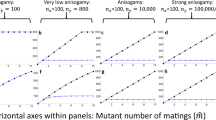Abstract
Arising from: O. P. Höner et al. Nature 448, 798–801 (2007)10.1038/nature06040; Höner et al. reply
In their investigation into whether female mate-choice drives male dispersal, Höner et al.1 argue that female spotted hyaenas (Crocuta crocuta) prefer mates whose tenure in the social group is less than the females’ age, to avoid paternal incest, and suggest that male dispersal reflects this preference. However, we are not persuaded that females choose mates on the basis of tenure because Höner et al.1 overlook the alternative hypothesis that dispersal status itself is important in female mate-choice2,3, such that females prefer immigrants over natal males. Like mate-choice based on tenure, choice based on dispersal status reduces the risk of incest.
Similar content being viewed by others
Main
Female hyaenas discriminate immigrants from natal males4, so if natal males sire offspring in proportion to their abundance, this argues against female choice based on dispersal status. Behaviourally, 11% of Ngorongoro Crater males “started their reproductive career” in their natal groups1. On the basis of comparable behaviours, 68% of males born in a Masai Mara population also did so5. (Note that this Crocuta population is the same one from which we derived the data for our Fig. 1.) Nevertheless, adult natal males were less likely to father any cubs than were immigrants2 and natal males sired only 2.7% of cubs, although they comprised more than 20% of adult males2 (χ2 = 16.04, degrees of freedom, d.f. = 1, P < 0.001). Thus, prior paternity data2 indicate that females avoid mating with natal males, preferring immigrants.
(N = 76 litters.) Filled circles, litters sired by immigrants who joined the clan after the mother was born, supporting mate-choice based on both dispersal status and tenure. Open circles, litters sired by immigrants who were present in the clan when the mother was born, supporting choice based on dispersal status but not tenure. Open squares, litters with a natal male sire younger than the mother, supporting choice based on tenure but not dispersal status.
Mate-choice in hyaenas often seems, perhaps coincidentally, to reflect both choice based on tenure and choice based on dispersal status. Of 76 litters born in the Masai Mara study population (see above), 51 (67.1%) were sired by males consistent with both choice based on tenure and dispersal status (Fig. 1). Therefore, we focus on the remaining 25 litters, which allow us to distinguish between the two competing hypotheses. Of these 25 litters, 22 (88%) were sired by immigrants present in the clan when the mothers were born, supporting choice based on dispersal status, but conflicting with choice based on tenure. However, only 3 out of 25 litters (12%) were sired by natal males born after the mothers, supporting tenure-based choice while conflicting with choice based on dispersal status. Thus, most of our informative litters support female choice based on dispersal status, and conflict with choice based on tenure. Although most (89.6%) Ngorongoro Crater litters seem to support tenure-based mate-choice1, Höner et al.1 present no paternity data comparing reproductive success between immigrants and natal males. Without such data, we cannot know whether Ngorongoro Crater females prefer immigrants as mates.
Furthermore, Fig. 1 and related analyses of Höner et al.1 may derive from female preference for immigrants2, coupled with age differences between natal females and immigrant males. If litters in Fig. 1 of Höner et al.1 were sired primarily by immigrants, as indicated by our data, and Ngorongoro Crater males immigrate when about 4 years old, as elsewhere6,7, then their Fig. 1 and ours both compare females of age X years with males aged (X + 4) years. Males survive no longer than females8, so both figures may reflect a dearth of old males, not tenure-based mate-choice.
We do not suggest that females in this or other species choose mates based solely on male dispersal status. However, male-biased dispersal is common among mammals9,10, so dispersal-based mate-choice could occur in many species. By contrast, tenure-based choice is possible only in social systems like that of Crocuta, so it cannot explain widespread sex differences in dispersal behaviour. In addition, because spotted hyaenas discriminate maternal kin, paternal kin, and sires from non-kin11,12, females might choose mates based on several criteria. However, the role of male tenure in female mate-choice1 remains unclear.
Methods
We quantified female mate-choice in a large Kenyan social group by classifying hyaenas as adults at 24 months of age1, considering immigrants as residents 3 months after their arrival1, and assigning kinship by paternity analysis2. We assigned paternity to 76 out of 110 litters born in 1989–2000. Five litters were sired by multiple males. Such litters occur near Ngorongoro Crater6, but it is unclear how Höner et al.1 treated such litters; for these, we plot the sires’ average tenure.
References
Höner, O. P. et al. Female mate-choice drives the evolution of male-biased dispersal in a social mammal. Nature 448, 798–801 (2007)
Engh, A. L. et al. Reproductive skew among males in a female-dominated mammalian society. Behav. Ecol. 13, 193–200 (2002)
Lehmann, L. & Perrin, N. Inbreeding avoidance through kin recognition: choosy females boost male dispersal. Am. Nat. 162, 638–652 (2003)
Szykman, M., Van Horn, R. C., Engh, A. L., Boydston, E. E. & Holekamp, K. E. Courtship and mating in free-living spotted hyenas. Behaviour 144, 815–846 (2007)
Holekamp, K. E. & Smale, L. Dispersal status influences hormones and behavior in the male spotted hyena. Horm. Behav. 33, 205–216 (1998)
East, M. L. & Hofer, H. Male spotted hyenas (Crocuta crocuta) queue for status in social groups dominated by females. Behav. Ecol. 12, 558–568 (2001)
Van Horn, R. C., McElhinney, T. L. & Holekamp, K. E. Age estimation and dispersal in the spotted hyena (Crocuta crocuta). J. Mamm. 84, 1019–1030 (2003)
Boydston, E. E., Kapheim, K. M., Van Horn, R. C., Smale, L. & Holekamp, K. E. Sexually dimorphic patterns of space use throughout ontogeny in the spotted hyaena (Crocuta crocuta). J. Zool. 267, 271–281 (2005)
Greenwood, P. J. Mating systems, philopatry and dispersal in birds and mammals. Anim. Behav. 28, 1140–1162 (1980)
Lawson Handley, L. J. & Perrin, N. Advances in our understanding of mammalian sex-biased dispersal. Mol. Ecol. 16, 1559–1568 (2007)
Wahaj, S. A. et al. Kin discrimination in the spotted hyena (Crocuta crocuta): nepotism among siblings. Behav. Ecol. Sociobiol. 56, 237–247 (2004)
Van Horn, R. C., Wahaj, S. A. & Holekamp, K. E. Role-reversed nepotism among cubs and sires in the spotted hyena (Crocuta crocuta). Ethology 110, 413–426 (2004)
Author information
Authors and Affiliations
PowerPoint slides
Rights and permissions
About this article
Cite this article
Van Horn, R., Watts, H. & Holekamp, K. Do female hyaenas choose mates based on tenure?. Nature 454, E1 (2008). https://doi.org/10.1038/nature07122
Received:
Accepted:
Issue Date:
DOI: https://doi.org/10.1038/nature07122
Comments
By submitting a comment you agree to abide by our Terms and Community Guidelines. If you find something abusive or that does not comply with our terms or guidelines please flag it as inappropriate.




